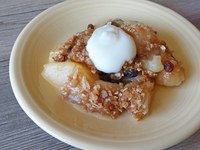Prairie Fare: Do You Have Any Dietary Restrictions?
(Click an image below to view a high-resolution image that can be downloaded)
By Julie Garden-Robinson, Food and Nutrition Specialist
NDSU Extension Service
I have been to several professional development conferences lately. Most of the registration forms have a common information request: “Please indicate your dietary restrictions.”
Fortunately, I eat most foods, except liver and limburger cheese. I never have been served either at a conference, though.
Conference planners usually feature fairly “neutral” choices on banquet menus. I wonder how many times I have had chicken, rice pilaf, mixed vegetables and rolls at conferences.
At one conference I attended, every meal featured cheesecake as the dessert. I guess the chef liked to make cheesecake, or maybe the conference planners received a volume discount on five kinds of cheesecake. I didn’t eat cheesecake for a long time after that event.
Sometimes I am seated next to someone with a different-colored menu choice card. This signals the serving staff to provide the person with a different entree.
Usually the “other choice” is a vegetarian entree; however, plant-based diets can be variable, too. Some vegetarians will eat eggs and/or milk. Vegans avoid all animal-based products.
At my last conference, I chose a boxed lunch with a grilled portobello mushroom and pepper sandwich with balsamic vinegar. No, I didn’t steal someone’s vegetarian entree. This menu choice sounded more interesting than a turkey and cheese sandwich.
In some cases, religious practices influence dietary choices. Some religions do not allow consumption of pork, caffeinated foods and beverages, or other foods.
Eating and menu planning can be kind of complicated at times.
People with food allergies or “food hypersensitivity” may experience symptoms ranging from skin rashes to life-threatening difficulty breathing. When a person consumes the allergen-containing food, their immune systems kick into high gear. Without prompt medical attention, some allergic responses can be fatal.
Peanuts, tree nuts, milk, eggs, wheat, soy, fish and shellfish are the most common food allergens. Fortunately, people with allergies can read the allergen warning required on the ingredient statement on all packaged foods. Those with food allergies also must avoid cross-contamination of other foods with the allergen during meal preparation.
Sometimes people use the word “milk allergy” and “lactose intolerance” to mean the same thing, but they are different conditions. People with lactose intolerance are not “allergic” to milk. They must avoid or limit milk-containing foods or take an enzyme tablet that provides their body with the “lactase” enzyme that lets their body break down lactose.
Without these precautions, people with lactose intolerance might suffer bloating, pain and/or diarrhea. However, sometimes those with lactose intolerance are able to consume smaller amounts of milk with meals or they may tolerate yogurt or cheese.
Gluten-free foods have become increasingly common in grocery stores; however, not everyone needs to avoid gluten. Those with celiac disease need to avoid gluten found in wheat, barley and rye because the proteins affect the lining of the intestine and can have many effects.
Be sure to discuss gastrointestinal and other medical issues with your medical provider for the proper testing and diagnosis.
Other people take medications that may interact with components in foods. For example, people taking certain cholesterol-lowering medications must avoid grapefruit. Those on certain blood thinners must keep leafy greens at a consistent level in their diet to avoid affecting the action of the drug they are taking.
If you are on a prescription, be sure to follow the guidelines provided by your pharmacist and included on the printed material you receive.
What do you do if you are having guests at your home and people have dietary restrictions? Maybe Aunt Carol has celiac disease, Uncle Bob is on a sodium-reduced diet and Cousin Ben has a peanut allergy. You might feel the need to have a “BYOF” (bring your own food) party.
Preparing food for special diets takes a little extra planning and requires attention to the ingredients and recipes. Choose more whole food and simple recipes. Be aware of the ingredients in the food products you are using. Set up a buffet and put a copy of the recipe by the item.
Be sure that guests can read the label on sauces, condiments or dips in case they need to avoid certain ingredients.
Recently, I worked with six dietetic interns to create several fact sheets with information about food allergies and some tested recipes. Visit https://www.ag.ndsu.edu/food/food-preparation to see the fact sheets.
Here’s a simple dessert recipe to top off a meal. It contains no peanuts, so Cousin Ben could enjoy a piece. Uncle Bob would have no issue with the sodium content (at 10 milligrams per piece). Aunt Carol would need to substitute a different grain ingredient, though.
Pear Crisp
1/4 c. all-purpose flour plus 1 Tbsp.
1/4 c. old-fashioned oats
1/4 c. sugar
1/4 c. brown sugar
1/2 tsp. cinnamon
1/2 tsp. nutmeg
2 Tbsp. butter
6 medium pears, cored and sliced
1/4 c. raisins (or dried cranberries)
1 Tbsp. lemon juice
2 Tbsp. sugar
1/8 tsp. nutmeg
1 pinch of cloves
In a bowl, combine 1/4 c. flour, oats, sugars, cinnamon and nutmeg. Cut in chilled butter using a pastry blender until crumbly. In a separate bowl, toss pears with raisins (or cranberries), lemon juice, 2 Tbsp. sugar, 1 Tbsp. flour, nutmeg and cloves. Spoon pear mixture into one 8- or 9-inch round cake pan sprayed with nonstick cooking spray. Cover pear mixture with the oat mixture and press down gently. Bake at 375 F for 45 to 50 minutes. Crisp is done when topping has browned and pear juice bubbles to the top. Top with whipped cream if desired.
Makes nine servings. Each serving has 190 calories, 3 grams (g) fat, 1 g protein, 35 g carbohydrate, 4 g fiber and 10 milligrams sodium.
(Julie Garden-Robinson, Ph.D., R.D., L.R.D., is a North Dakota State University Extension Service food and nutrition specialist and professor in the Department of Health, Nutrition and Exercise Sciences.)
NDSU Agriculture Communication - May 18, 2017
| Source: | Julie Garden-Robinson, 701-231-7187, julie.garden-robinson@ndsu.edu |
|---|---|
| Editor: | Ellen Crawford, 701-231-5391, ellen.crawford@ndsu.edu |



